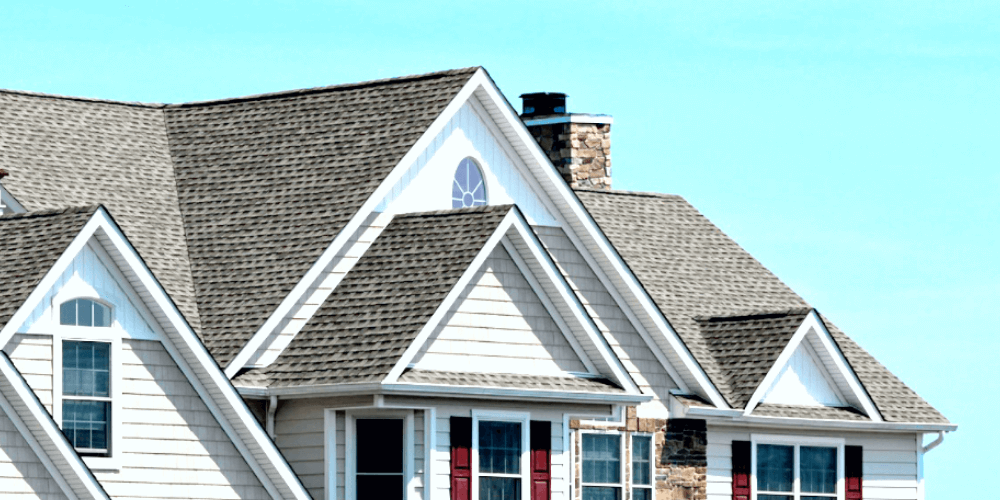Roof Replacements - A Guide To a Re Roof
Every roof has an end date. Replacing a roof on a house is a time-consuming but necessary task for most individuals. When the time comes to replace the roof, to ensure that the job is completed correctly, you must know what procedures to follow. Even if you hire a roofing contractor to do the project for you, you’ll want to know what they’ll be doing each step of the way so you know what to expect. Below is a guide to roof replacement.
The Basic Roofing Materials
Your options of roofing materials are influenced by your location and preferences. These are the most typical roofing systems.
Asphalt Composition Shingles
These are inexpensive and readily available, but their flat design makes them less appealing than alternative possibilities. It is the most common roofing material. Composition shingles are often built of either organic (consisting of a cellulose-fiber) base saturated with asphalt and coated with colored mineral granules) or fiberglass (consisting of a fiberglass mat, top-and-bottom layers of asphalt, and mineral granules). In as little as eight years, composition roofs will require maintenance or repair. High winds can readily destroy this material, causing the shingles to blow off. Curling, cracking, and streaking of the shingles can occur due to extreme heat, severe rains, and other weather conditions, reducing the appearance and effectiveness of your roof. Re roof is necessary several times throughout the lifetime of an ordinary home with composition shingles resulting in the trash that must be disposed of in the environment.
Clay and Concrete
These are inexpensive and readily available, but their flat design makes them less appealing than alternative possibilities. It is the most common roofing material. Composition shingles are often built of either organic (consisting of a cellulose-fiber) base saturated with asphalt and coated with colored mineral granules) or fiberglass (consisting of a fiberglass mat, top-and-bottom layers of asphalt, and mineral granules). In as little as eight years, composition roofs will require maintenance or repair. High winds can readily destroy this material, causing the shingles to blow off. Curling, cracking, and streaking of the shingles can occur due to extreme heat, severe rains, and other weather conditions, reducing the appearance and effectiveness of your roof. Throughout its lifetime, an ordinary home with composition shingles will need to be re-roofed several times resulting in the trash that must be disposed of in the environment.
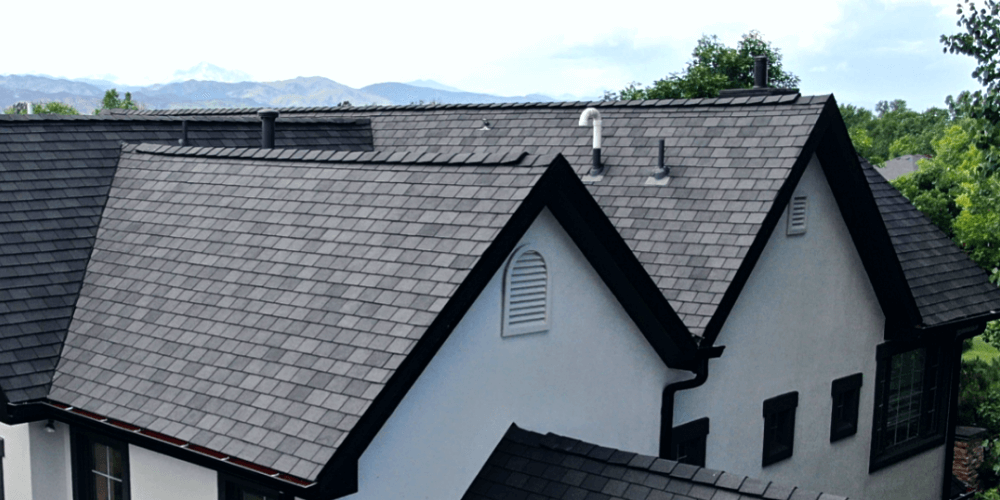
Composition Slate
These synthetic tiles are made of 95% recycled materials. They are similar to slate and other types of stone tile, but they are less prone to damage and lighter. Because all forms of synthetic slate may be recycled at the end of a roof’s useful life, this is considered a green building option. It has advanced UV inhibitors to protect against sun degradation and impact modifiers to help storm damage.
Metal Roofing
Metal is one of the most long-lasting roofing materials, often with a lifetime warranty. Metal roofs are available in bespoke shapes, designs, and materials, including Colorbond, aluminium, high-grade steel, and copper. These are pricey roofs that require specialized professionals to install because of their lengthy lifespan and cost-efficiency. Metal roofing systems come in styles, including raised-seam panels and items that appear like composite shingles.
Slate Roofing
Slate is one of the best types of roofing materials utilised in the business, and are a popular choice for roof replacement tasks. Slate is a natural, mined stone that weighs less than many other types of tiles and requires reinforced structure in most cases. Slate tiles can be pricey, but they can easily endure moisture, fire, and insect damage, with a typical lifespan of more than 100 years. It is a beautiful, high-end roofing alternative, but it is also expensive and heavy. Slate roofs are dangerous to walk on and difficult to restore if they are broken.
In This Article
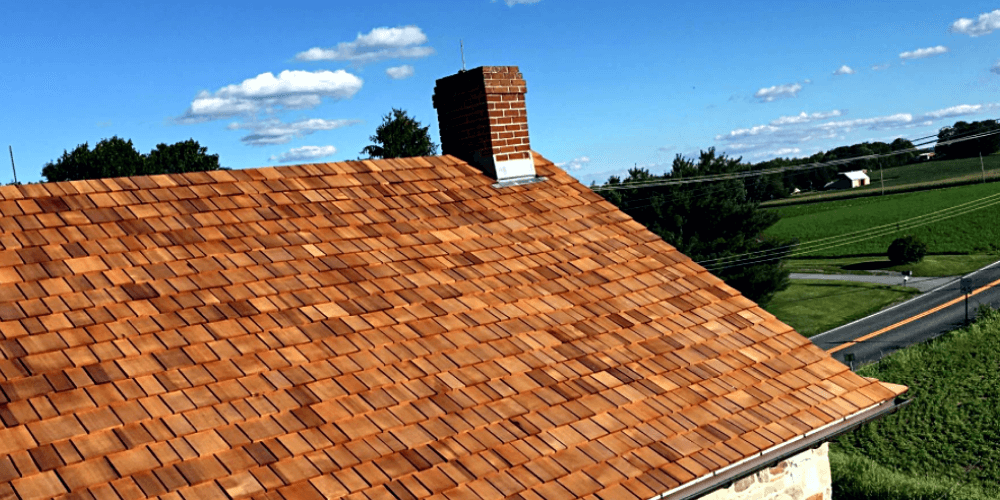
Wood Shakes or Shingles
These are made of cedar, redwood, southern pine, and others; wood shingles are machine sawn, whereas shakes are created by hand and have a rougher appearance. The shingles are costly, but they look great. These are tough, but they are not a smart choice in areas where there is a risk of fire.
A form of wood roofing material manufactured by splitting thin rectangles of wood off a log is known as wood shake. The two types of wood roofing materials are wood shingles and wood shakes. Wood shingles, as opposed to wood shakes, are sawn on both sides and thinner at the bottom. Wood shakes are thicker than shingles because they are sewn on one side and hand-split on the other. Both are wedge-shaped and fastened to a roofing deck independently.
A wood shingle roof will have a much smoother and more consistent appearance. A roof made of wood shakes will appear more rustic and natural.
Understanding the Roofing Process
A reasonably sized and professionally-installed roofing job might be completed in as little as three or four days. The following is the general procedure followed by the roofing crew.
Setting Up for Your Roof Replacement
All existing shingles should be removed and thrown away in a roll-off dumpster. At this point, any damaged or old valley flashing or drip edging is also removed. During tear-off, a skilled crew will utilise tarps to protect foundation plantings and shrubs, and magnetic equipment to remove nails and metal objects from the lawn.
Clear Away Old Roofing Material
Install ice dam protection in areas where it is needed. The Ice Guard membrane is a synthetic waterproof barrier meant to keep melting ice from backing up under the shingles and seeping through the sheathing, causing serious damage.
Change Out Old Flashing and Put Down the Underlayment
Install asphalt roofing paper over the roof sheathing to form an inner barrier that prevents water from reaching the house. Rows of roofing paper are overlapped and tacked or stapled in place as they progress upward toward the apex. Apply metal drip edging to both the gable and eave sides of the roof’s edge. Over the roofing paper or ice guard, the metal drip edge is nailed in place. Install new valley flashing where necessary, especially where two roof planes meet: Valley flashing is normally affixed to the roofing deck and sealed with roofing caulk. With the tab shingles, begin at the eaves and work your way up to the peak. As the tiles progress toward the top, roof vents are placed where they are required. Apply the flashing to the chimney, skylights, stack vents, and any other areas where a leak could enter the house. Flashing installation may take place when the rows of shingles progress upward on the roof deck as part of the roofing procedure.
Installing the New Roof
Place the ridge vent in its proper location. This continuous vent runs the length of the roof’s peak, aiding air circulation in the attic space and maybe reducing ice dams in the winter. Although ridge vents may not be present on older roofs, they are a smart idea to include when a home is re-roofed. Other types of roof or gable vents should be created to allow air to circulate in the attic space if ridge vents aren’t a possibility.
Cleanup and Final Inspection
The crew will clear up any residual debris from the installation once the roofing materials have been completed, ensuring that the house is clean for the homeowner. The job is considered finished if the contractor is happy that the new roof fulfills its quality standards. The homeowner may rest easy knowing that they have a roof over their heads that will offer them all of the protection they require for a long time.
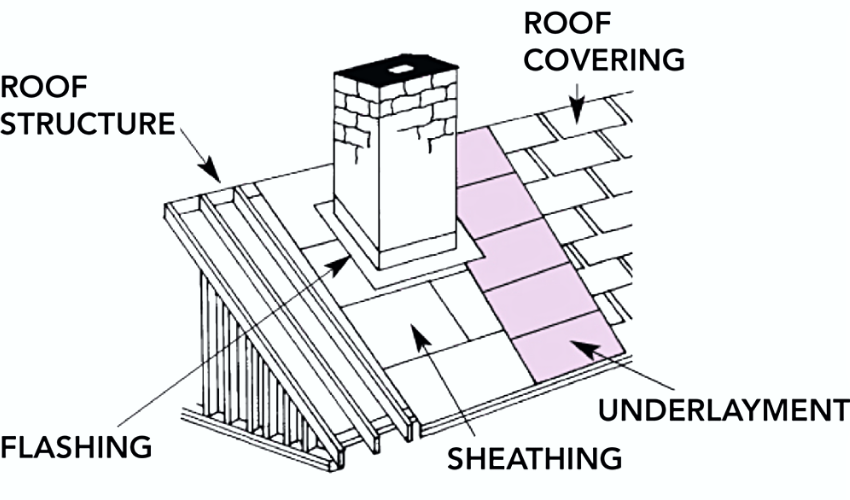
Roof System Components
There are five main components to all steep-slope roof systems.
- Roofing materials include shingles, tile, slate, or metal, and underlayment to protect the sheathing from the elements.
- The sheathing is a term used to describe boards or sheets of material that are secured to roof rafters to cover a home or structure.
- The roof structure is made up of rafters and trusses that support the sheathing.
- Flashing is sheet metal or other material that is put into the different joints and valleys of a roof system to prevent water seepage.
- Drainage is the ability of a roof system’s architectural features, such as shape, slope, and arrangement, to shed water.
Ventilation and Insulation
Proper ventilation is one of the most important aspects of roof system durability. Heat and moisture build-up in an attic without it, causing decay in the rafters and sheathing, shingles to buckle, and insulation to lose effectiveness. It is critical not to close off roof ventilation sources like louvers, ridge vents, or soffit vents in the winter. Proper attic ventilation will assist to minimize moisture-related structural damage, extend the life of roofing materials, reduce energy consumption, and improve the comfort of the areas below the attic.
Insulation, in addition to the free movement of air, is critical for proper attic ventilation.
Factors Affecting the Roof System Performance
The following information will assist you in making informed roof system purchasing decisions.
Condensation
It is caused by the accumulation of relatively warm, moisture-laden air. Moisture in an attic with insufficient ventilation increases the degradation of wood sheathing and rafters, potentially compromising the roof structure. Installing larger or extra vents will provide adequate attic ventilation, which will help to alleviate difficulties by bringing the attic air temperature closer to that of the outside air.
Flashing Deterioration
Many purported roof leaks are flashing leaks. Water can enter a home or structure without adequate, tight flashings around chimneys, vents, skylights, and wall/roof junctions, causing damage to walls, ceilings, insulation, and electrical systems. As part of a biannual roof inspection and gutter cleaning, flashings should be checked.
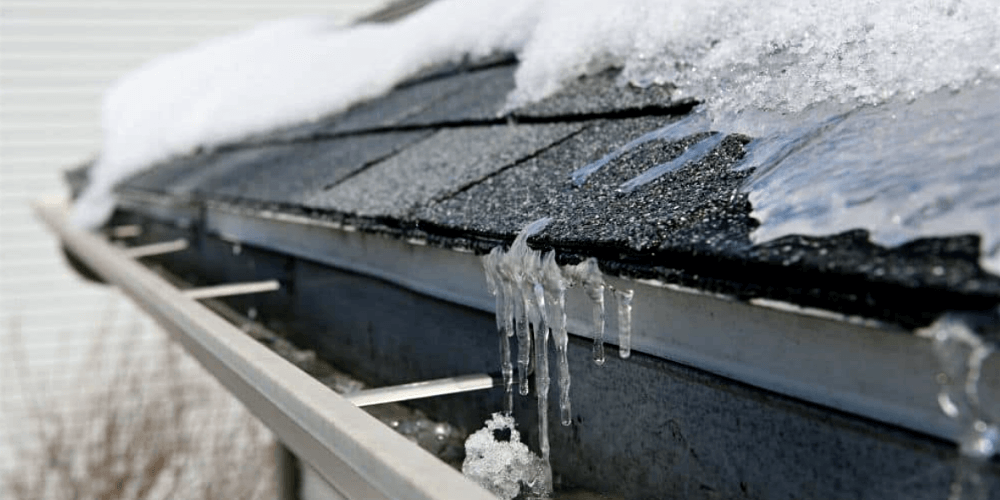
Ice and Snow
These obstruct adequate gutter drainage. Water accumulates beneath the shingles (or other roofing components) and penetrates the interior. Gutters and downspouts can be the first to fill with ice during the early phases of the thaw and be damaged beyond repair or even pulled off a house or building.
Missing or Torn Shingles
Complete protection is the key to a roof system’s success. A roof structure and the interior of a home or building are prone to water damage and rot when shingles are missing or torn off. Nearby shingles are also easily ripped or blown away, so the problem is likely to spread. Shingles that are missing or torn should be replaced as soon as feasible.
Rain
Water that gets below shingles, shakes, or other roofing materials can seep into the roof deck and damage the roof structure. Mildew and rot thrive in high-moisture environments, such as walls, ceilings, insulation, and electrical systems.
Shingle Deterioration
Curling, splitting, and loss of waterproofing effectiveness occur as shingles become old and worn out. Wind gusts can easily blow shingles off, tear them, or lift them. The end effect is structural decay and harm to the interior. A failing roof system will only get worse over time and should be replaced as soon as feasible.
Sun
Heat and ultraviolet light degrade roofing materials over time. On the sides facing west or south, deterioration can be more rapid.
Trees and Leaves
When tree branches come into contact with a roof and are driven by the wind, they scratch and gouge the roofing materials. Overhanging tree branches can harm, if not pierce, shingles and other roofing components. Leaves on the surface of a roof system absorb moisture and promote damage; gutters obstruct drainage.
Winds
High winds can lift the edges of shingles (or other roofing materials), forcing water and debris beneath them. Strong winds can cause significant harm.
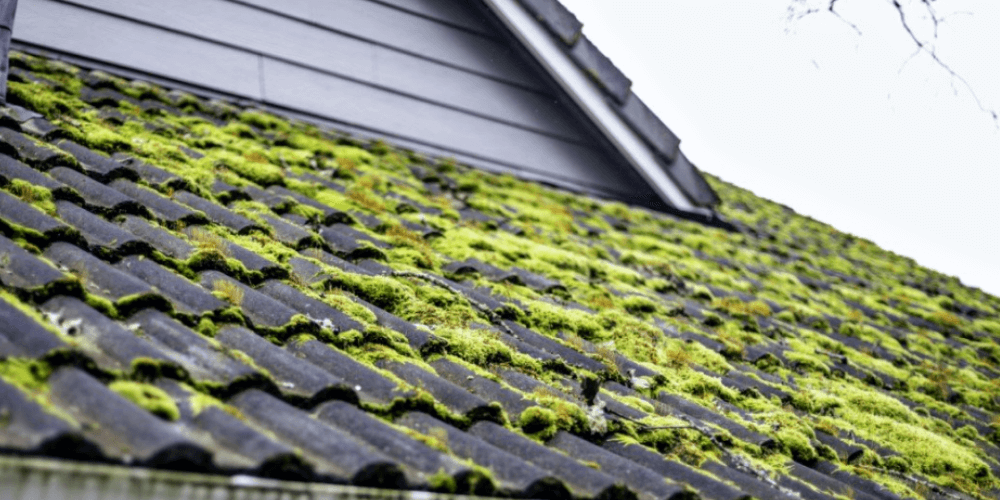
Moss and Algae
Moss and algae thrive in damp wood shingles and shakes. Moss traps more moisture to the surface of a roof system as it develops and causes decay. Moss roots can potentially find their way through a wood deck or structure. Algae can also grow on wood or asphalt shingle roofs in wet, shady places. Algae can hold moisture, causing decay and deterioration, in addition to leaving a black-green stain. Trees and bushes should be trimmed away from homes and structures, and gutters should be kept clean to guarantee proper drainage to avoid wet, shadowed areas.
Common Questions Regarding Roof Replacement
Although understanding the phases of roof replacement and roof restoration will help you prepare for the job, you may still have some concerns. Here are some of the most often asked questions by individuals in need of a new roof.
Is There a Best Time for a Roof job?
You might be asking when the best time is to replace your roof. However, there is no one-size-fits-all approach to scheduling your job. You should complete the task as quickly as feasible. It is because delaying a roof replacement could result in further damage to your home. You risk water damage and other difficulties if you wait too long to replace it. It is preferable to schedule your replacement as soon as possible.
How Long Does it Take to Complete the process?
There’s no way to know how long a roof replacement will take in advance, just as there’s no way to know how long any other house repair will take. The schedule is determined by several criteria, including the new roof’s material, the type of roof, and the crew’s experience.
A wood shakes roof typically takes three to four days to install. The synthetic slate may take a little longer. A concrete tile roof, on the other hand, takes roughly eight or nine days to install. Natural slate roofs take longer to install than typical materials due to their substantial weight. It typically takes six to seven days. Asphalt shingles are by far the easiest to install, taking only one or two days to complete. However, the size of your home has a direct impact on how long it takes to replace your roof.
Do I Need To Move Out Of My Home While My Roof Is Replaced?
Unusually, a new roof installation or re-roofing job will need you to evacuate your building entirely. Tarps and other barriers are used by professional roofing companies to protect your property and garden from harm. During this time, pay attention to when our skilled roofers identify areas of hazard that you should avoid while the job is being done, and stay away from them.
Is it Better to Tear Off or Add a Second Layer?
It used to be usual practice to lay a new shingle roof over the old one at least once, if not twice. Even if layering is permitted, laying a fresh layer of shingles over an existing one should be done with caution.
Telegraphing
Another issue with shingling over existing shingles is that you’re just reproducing some of the surface flaws that are already there. If you’re thinking about getting a new roof, there’s a strong possibility you’ll find bubbles, bumps, and waves that need to be addressed. Installing new shingles over existing faults can result in an unappealing new roof. Going through the existing roof and correcting as many flaws as possible before re-roofing is one strategy to reduce this problem. To fix irregularities, gaps, and protruding nails, all you need is a hammer, some roofing nails, and a handful of shingles.
Weight
The main argument against adding more layers of asphalt shingles is that the roofing materials can become too heavy for the roof framework. It can be a structural issue, particularly in older homes. A triple layer of asphalt shingles is compared to a single layer of slate shingles, which is a heavy material.
Work and Waste Reduction
The main benefit of layering is that it decreases the amount of effort required. More work is added to the process by removing the previous layer and then laying down a new one.
What are the Cost Considerations in Roof Replacement?
The cost of a roof is determined by several factors, beginning with the roofing materials you select. Other elements that affect the cost include the roofing contractor you hire, the pitch, and the square footage of your roof.
- Asphalt roof shingles are a robust yet lightweight roofing technology that resists salt, UV, and mildew and come in colors for outstanding curb appeal. It is worth investing in high-quality asphalt shingles with a 20-year algae-free warranty and a 15-year wind warranty that can be transferred to new owners if the house is sold. Asphalt roof shingles cost $55 per square metre on average.
- Concrete and clay roof tiles come in colors and profiles to complement both conventional and contemporary home designs. Terracotta roof tiles retain their color even after years of exposure to the elements. Tiles are also long-lasting, performing well in high-wind zones and coastal areas. They won’t rust, distort, or corrode, prevent heat loss, and act as a sound barrier. Concrete and clay are not lightweight materials, trusses must be checked for strength. To keep moss and lichen from growing on your tiles, you may need to spray them now and then. Concrete costs $52 per square metre on average, while clay costs $104 per square metre.
- Metal roof tiles have the appearance of traditional tiles and shingles, and the average price for metal roof tiles is $50 to $70 per square metre, thanks to UV protection technology and light-fast colors.
- Slate will provide you with 100 years of service or more. It is resistant to UV rays, salt spray, acid rain, and snow and ice damage. However, slate is a heavyweight roofing material, weighing in at roughly 38 kilograms per square meter, so the structure beneath it needs to be strong enough to support it. Slate roofs cost an average of $280 per square metre.
- They can be manipulated through all types of architectural curves and corners, giving renovators a vast range of design options. No two pieces are identical, resulting in a unique look each time, and can be manipulated through all types of architectural curves and corners, giving renovators a vast range of design options. Staining or painting wood is also an option. It is a renewable resource that can help insulate buildings more effectively than other materials, lowering energy expenses. Cedar shingles and timber shakes can endure up to ten years longer than other goods if location, climate, and home surroundings are considered. Wood roofs cost an average of $160 per square metre.
Roof replacement costs might vary. There is no typical price because each roof is unique. In Australia, however, the bulk of house re-roofing operations cost between $15,000 and $25,000.
What are the Factors Impacting the Cost of Roof Replacement?
Roofing materials and costs vary substantially. The final cost of a new roof will be influenced by its size and labor costs. Roof design, pitch, access, and environmental hazards are all factors that can increase your expenditures. Asbestos removal is the issue that can nearly quadruple the cost of a roof replacement.
Asbestos Cement Roof
The condition, amount, location, and accessibility of asbestos all play a role in its removal. If asbestos is present in your roofing materials, you should anticipate the cost of a new roof to rise. The asbestos-affected area must be removed by a professional removal company. Asbestos removal costs $250 for removing asbestos from the eaves of your roof to $5,500 for removing asbestos from the complete roof. Check to see if asbestos removal from your roof eaves was included in the original price.
Design of the Roof
If your roof design is sophisticated, roofing materials prices may be higher. You should inquire with your contractor about any particular requirements you have for your roof design that may be pushing up the price. If you aren’t trying to recreate a complex pattern, you may be able to get a lesser charge.
Difficult Site Access
If you live in a difficult-to-reach area or have an inaccessible roof, your roofing prices may rise. Accessing steep rooftops raises prices since your builder faces a greater danger of injury.
Environmental
There are energy-efficient roofing materials available that can help you save money on your cooling expenditures. Furthermore, if you live in a hot region, your roof may need to be composed of heat-resistant materials. For example, due to Australia’s intense sunlight, a synthetic slate tile has been known to break after ten years.
Labour Costs
Unless you ask your contractor, you may not know the exact labor charges. Find out what the hourly labor rates are and get a final quote indicative of how much effort it may take.
Maintenance Requirements
In most cases, your roofing process will involve the removal of old tiles, but you should double-check that these services are included in the official price before signing. You should inspect the roof every two to five years to keep it in good shape. It’s most likely that the edges will deteriorate first.
Pitch or Angle of your Roof
The cost of a steep roof may be higher due to the labor involved. If the slope is particularly steep, further preparation and specialized safety equipment may be required. Your roof’s slope may necessitate a more sophisticated design.
Roofing Material
Concrete shingles and asphalt shingles are two common roofing materials today. Human-made things are usually the most affordable. The cost of corrugated metal roofing is low, but copper is substantially more expensive. Clay has a nice appearance and is less expensive than a new tile roof. A renovated version of an old timber roof is a fun choice if it fits with the architecture of your home. You can, on the other hand, use a new waterproof membrane roof system.
Size of the Roof
When getting a price, your builder will most likely inquire about the square footage of your roof. As you can assume, a larger roof requires more materials and, as a result, more labor costs.
Conclusion
Your roof not only covers about 40% of your exteriors, but it also functions as a critical structural component for maintaining safe and comfortable living conditions. Periodic maintenance is required to ensure that your roof lasts as long as possible. We can do a complete evaluation of your roofing to establish whether or not re-roofing is required. Our focus is on holistic roofing solutions rather than just patch repair work.

